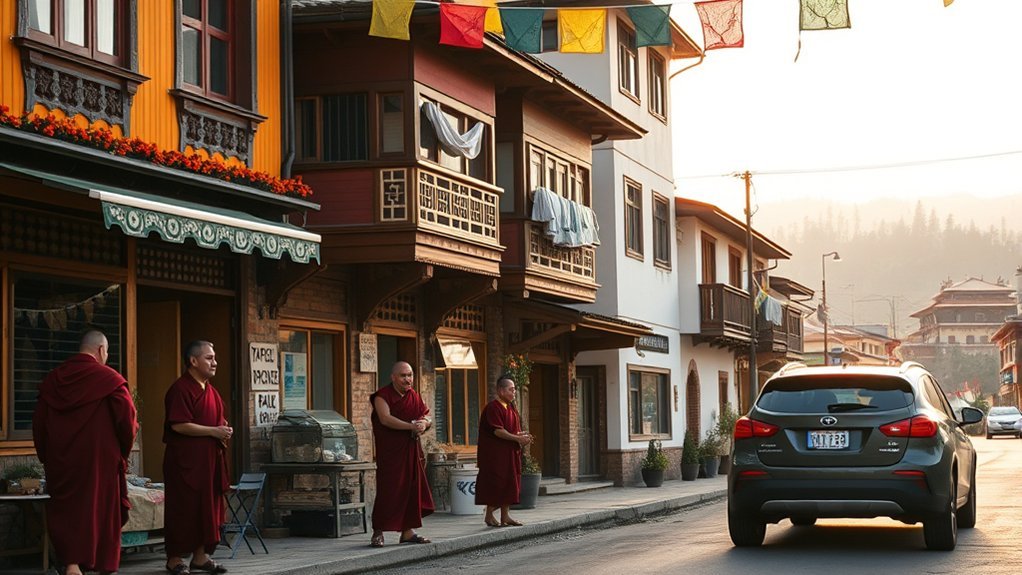You’ll find living in Bhutan is far cheaper than in the U.S.—overall costs run roughly one-eighth as much. Rent for a one-bedroom downtown averages about $168, utilities near $18, internet $21, and basic meals $2.80. Public transit passes cost around $4 and private preschool about $235 monthly. Healthcare and groceries are generally lower too, boosting disposable income and purchasing power; keep going to see itemized costs, housing options, and budgeting tips.
Overview of Bhutan’s Cost of Living and Price Index
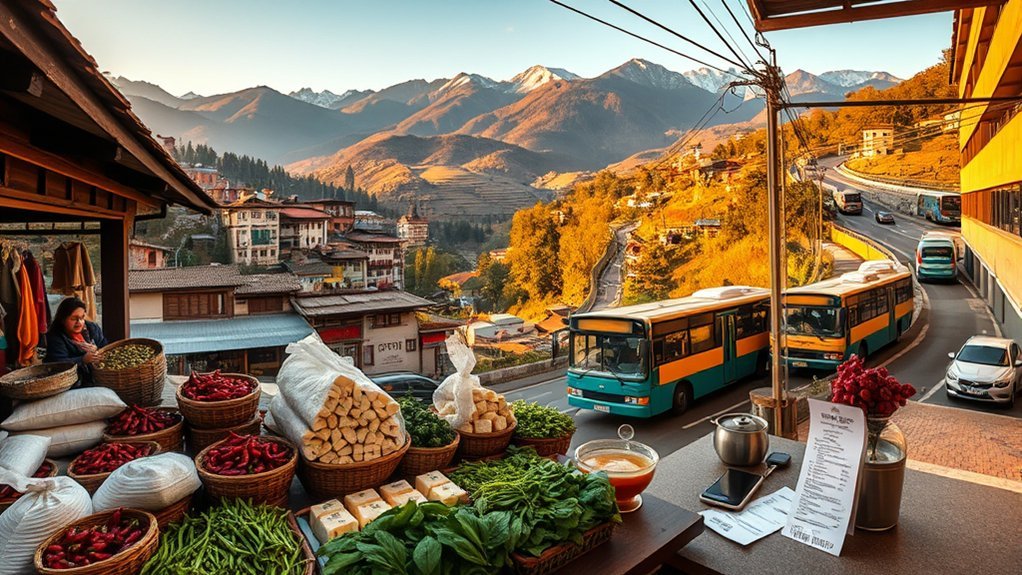
While Bhutan’s overall cost of living is substantially lower than in the United States, the difference is especially pronounced in housing, dining, and transportation: a downtown 1‑bedroom runs about $122.58 versus $1,664.59 in the U.S., a basic restaurant meal costs roughly $2.82 compared with $19.45, and a monthly public transit pass is near $4.01 versus $65.85; groceries follow the same pattern (a loaf of bread about $0.89 here versus $3.56 in the U.S.), which together produce a markedly lower consumer price index for everyday expenses.
You’ll see these data points drive a compressed Cost of Living Index for Bhutan relative to the United States. Comparing itemized prices—rent, meals, transit, staples—lets you quantify purchasing power differences: everyday baskets cost a fraction in Bhutan.
For budgeting or relocation, use these figures to adjust expectations and salary comparisons; inflation sensitivity remains, but baseline living costs are consistently lower across key categories.
Housing and Utilities: Renting and Buying in Major Cities
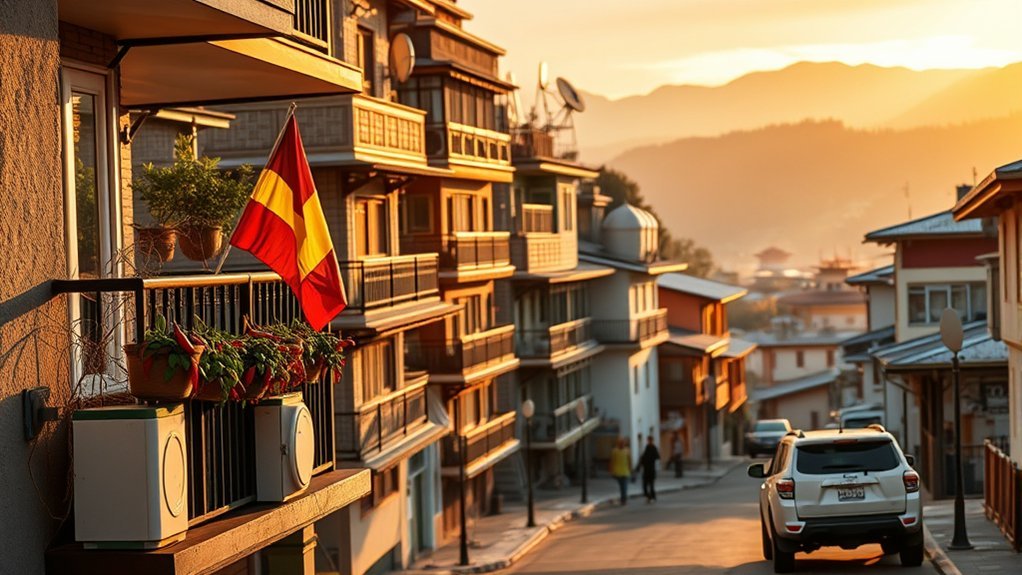
Although Bhutan’s housing market is compact, you’ll find rents and utilities are dramatically cheaper than in the United States: you’ll pay about $168 for a 1-bedroom downtown versus $1,664.59 in the U.S., and $98.8 outside center versus $1,341.
Although compact, Bhutan’s housing is far cheaper than U.S. rents — about $168 downtown versus $1,664.59 stateside.
For a 3-bedroom downtown expect roughly $257 compared with $3,124 stateside. Monthly utilities average $17.6 versus $124, and 50 Mbps internet is about $21.3 compared to $68.97.
- Downtown 1BR: $168 (Bhutan) vs $1,664.59 (U.S.)
- Outside 1BR: $98.8 vs $1,341
- Downtown 3BR: $257 vs $3,124
- Utilities & Internet: $17.6 utilities; $21.3 internet vs $124 and $68.97
You’ll notice housing density limits supply and resale complexities; buying options are smaller and often tied to local regulations.
Read Terms of Use for rental contract norms and Help us compare listings when relocating. This data-driven snapshot helps you plan budget allocations sharply.
Food and Groceries: Typical Prices and Monthly Budgets
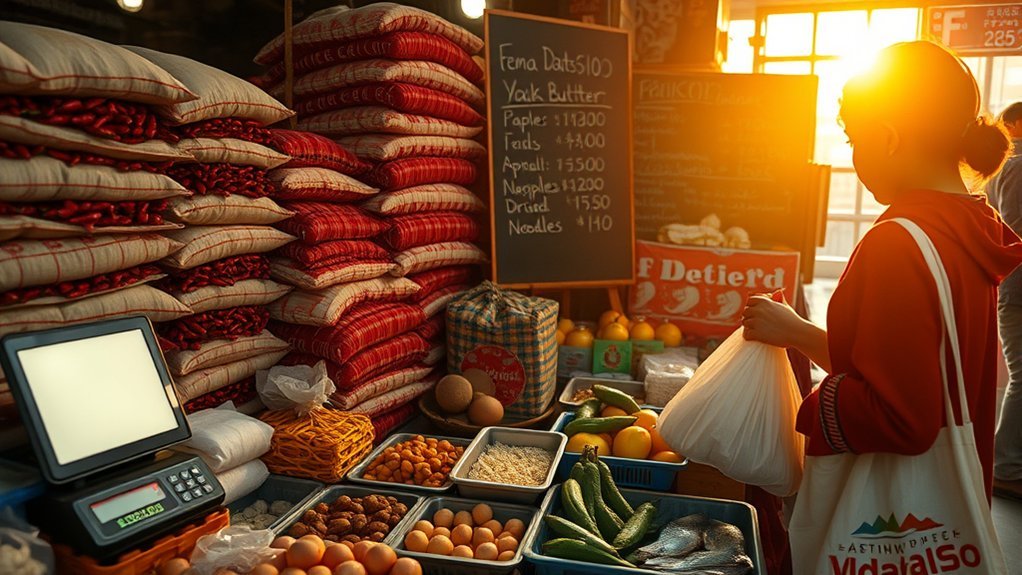
Food and groceries in Bhutan are noticeably cheaper than in higher-cost countries: a basic restaurant meal runs about $2.82 and a fast-food combo about $3.38, a loaf of bread is roughly $0.89, 8 oz of local cheese about $1.61, and a dozen eggs around $1.96, which lets you budget monthly groceries for a single person at roughly one-third the cost you’d expect in the United States (U.S. groceries average about 3.5× higher).
You’ll find most savings when you buy local food and staple items at traditional markets rather than imported goods at supermarkets.
Bread, eggs and local cheese are low-cost anchors; combining them with seasonal vegetables from market stalls drops per-meal cost further.
For grocery shopping, a conservative single-person monthly estimate factors in occasional packaged items and some imports, but remains well below Western norms.
If you focus on market produce, rice, lentils and dairy, expect predictable, measurable savings that translate into a noticeably smaller monthly food budget compared with higher-cost countries.
Dining Out and Entertainment Costs
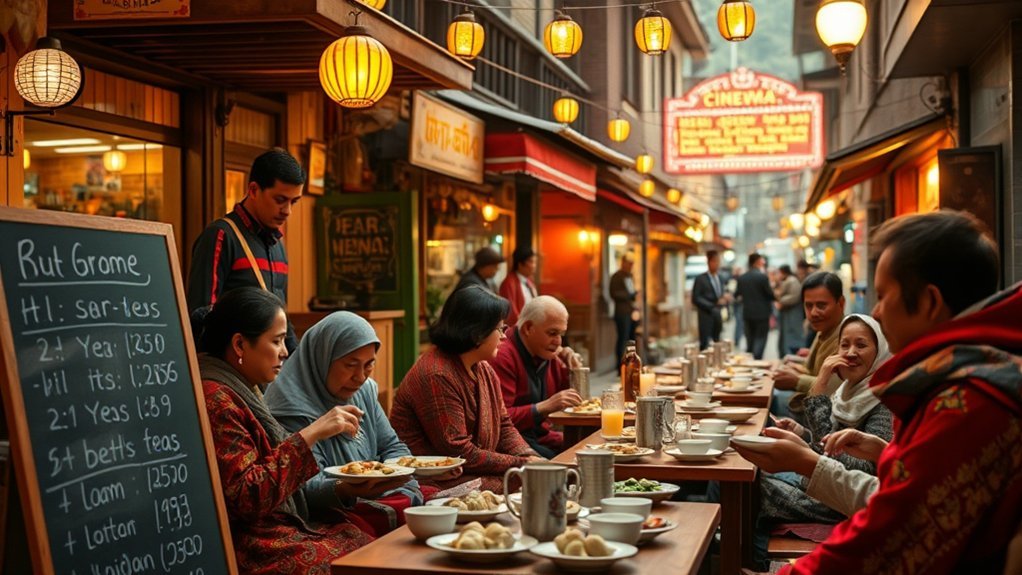
When you eat out in Bhutan you’ll see concrete savings: a basic meal with a drink is about $2.82 versus $19.45 in the U.S., and a fast-food combo runs $3.38 compared to $11.12.
Nightlife and drinks are similarly inexpensive — a beer in a pub is roughly $2.33 and a cappuccino about $1.84, versus $6.20 and $5.25 in the U.S.
A typical dinner for two averages $17.80 here against $78.20 abroad, underscoring consistent cost advantages.
Typical Meal Prices
Anyone looking to eat out in Bhutan will find costs noticeably lower than in the United States: a basic meal with a drink runs about $2.82 versus $19.45 in the U.S., a fast-food combo is $3.38 compared with $11.12, and a mid-range dinner for two averages $17.80 against $78.20; similarly, a local beer costs roughly $2.33 (vs. $6.20) and a cappuccino about $1.84 (vs. $5.25), illustrating consistent, substantial savings across casual dining, mid-range restaurants, and pub/coffeehouse expenditures.
You’ll notice lower prices reflect local sourcing and simpler meal preparation tied to traditional cuisine and dining customs.
Key typical costs:
- Basic meal with drink: $2.82
- Fast-food combo: $3.38
- Mid-range dinner for two: $17.80
- Cappuccino: $1.84
These figures show clear, quantifiable savings if you compare menu categories directly.
Nightlife and Drinks
While Bhutan’s nightlife is quieter than many countries’, its drink and dining prices are strikingly economical—expect a pub beer at about $2.33 (vs. $6.20 in the U.S.) and a cappuccino for roughly $1.84 (vs. $5.25).
You’ll find nightlife activities focused on small bars, cafés, and occasional live music rather than clubs. Comparative data shows lunch averages $3.24 (U.S. $19.30) and dinner for two about $17.80 (U.S. $78.20), so social evenings are affordable.
Drink varieties include local beers, spirits, and coffee-based options; fast-food combos run roughly $4.31 (U.S. $11.20). If you explore local breweries, you’ll see costs align with these low benchmarks, letting you sample multiple offerings without high expense.
Transportation and Fuel Expenses
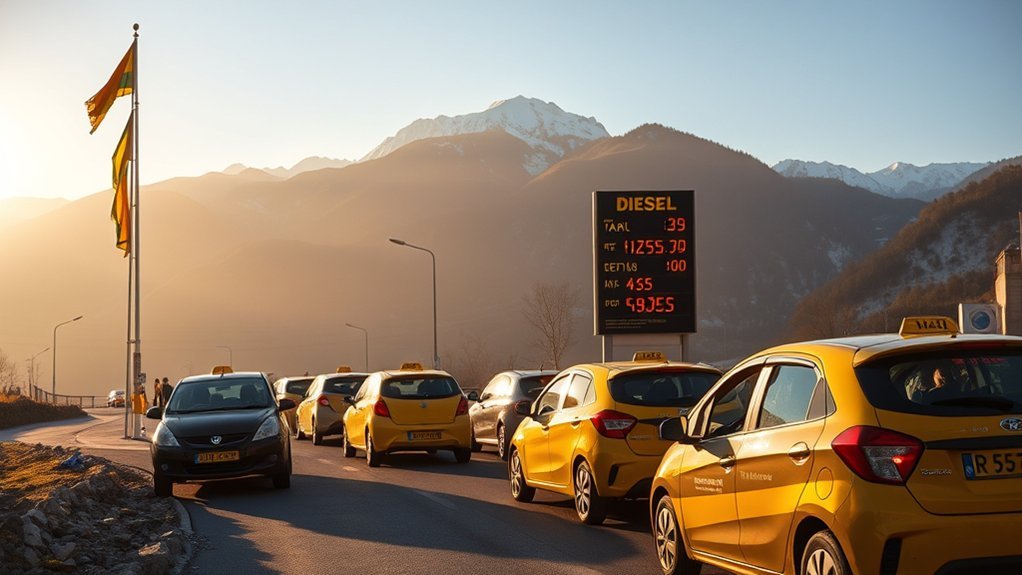
You’ll find public transit in Bhutan is exceptionally cheap at about $4.01 per month for a pass and $1.74 per local ticket, compared with roughly $65.85 and $2.35 in the United States.
Fuel trends are similar: gasoline runs about $3.03 per gallon in Bhutan versus $3.41 in the U.S., lowering household mobility costs.
Public Transit Costs
One monthly transit pass in Bhutan costs about $4.01, a fraction of the U.S. average of $65.85.
So if you rely on public transportation you’ll see immediate savings; local tickets run roughly $1.74 versus $2.35 in the U.S., and gasoline is slightly cheaper at $0.87 per gallon compared with $0.93.
Though taxi fares tell a different story—an average 5-mile downtown trip in Bhutan is about $18.89 versus $17.61 in the U.S.
You’ll notice clear public transit benefits: lower fares boost transportation accessibility and support eco friendly commuting.
Key figures to weigh before moving or budgeting:
- Monthly pass: $4.01 (Bhutan) vs $65.85 (US)
- Local ticket: $1.74 vs $2.35
- Gasoline per gallon: $0.87 vs $0.93
- 5-mile taxi: $18.89 vs $17.61
Fuel Price Trends
Having looked at fares and passes, let’s look at how fuel prices shape overall transport costs in Bhutan compared with the U.S.
You’ll see gasoline at about $3.03 per gallon in Bhutan versus $3.41 in the U.S., a small gap that limits household savings from fuel alone.
Gasoline market analysis shows modest fuel price fluctuations locally, so monthly commuting budgets remain predictable.
Given a local transport ticket at $11.70 monthly (vs. $69.30 in the U.S.) and single fares around $1.74 (vs. $2.35), you’ll rely more on public transit to cut costs.
Transportation policy impacts—subsidies, taxes, and limited road networks—keep overall transport costs in Bhutan roughly 6.2 times lower than U.S. averages despite some pricier short taxi trips.
Childcare, Education, and Healthcare Costs
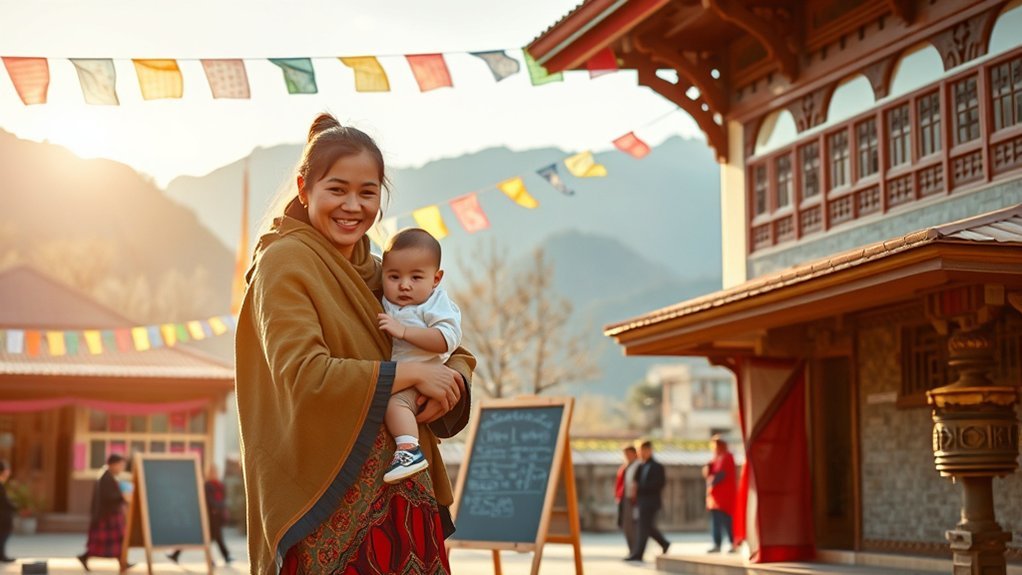
Although Bhutan’s childcare and schooling systems differ markedly from Western norms, families there face distinctly lower out-of-pocket costs for early childhood and basic healthcare services.
You’ll find childcare options are limited, so many families rely on extended relatives, reducing formal childcare expenses. Private preschool runs about $235.40/month per child versus the U.S. average of $1,387.27, a clear comparative savings.
Public education is free, though you’ll pay for uniforms, supplies, and activities; education quality varies by region and resources.
Healthcare accessibility is improving with more clinics and hospitals, and basic medical expenses are generally lower than in many Western countries, but specialized care can incur higher out-of-pocket costs.
- Private preschool: ~$235.40/month (Bhutan) vs $1,387.27 (U.S.)
- Public schooling: tuition-free; ancillary costs present
- Childcare options: informal family support common
- Healthcare accessibility: expanding, specialized care cost variable
These data-driven contrasts help you estimate household budgets in Bhutan.
Salary Adjustment and Purchasing Power Comparison With the United States
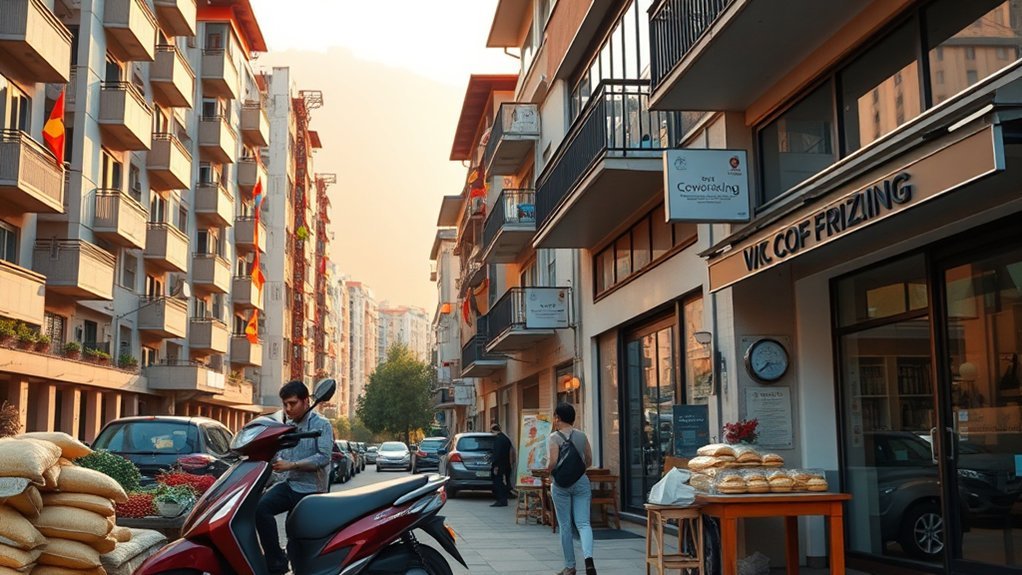
Because Bhutan’s overall costs run roughly 7.8 times lower than in the United States, your salary will need substantial adjustment to preserve purchasing power if you relocate; use purchasing power analysis to set realistic targets. Compare core items quantitatively so you can apply salary negotiation strategies and expatriate budget planning effectively.
| Category | Bhutan (USD) | U.S. (USD) |
|---|---|---|
| 1-bed downtown rent | 122.58 | 1,664.59 |
| Basic meal w/ drink | 2.82 | 19.45 |
| Monthly transit pass | 4.01 | 65.85 |
From these data, your effective purchasing power increases in Bhutan even with a much lower nominal wage. For negotiations, convert U.S. salary needs into Bhutan-stable costs, then apply a safety margin for imports and schooling. Expatriate budget planning should model scenarios: maintain current U.S. living standard, accept proportional local standard, or hybrid. Use the table numbers to justify offers and to quantify expected disposable income under each scenario.
Tips for Saving Money and Managing Living Expenses in Bhutan
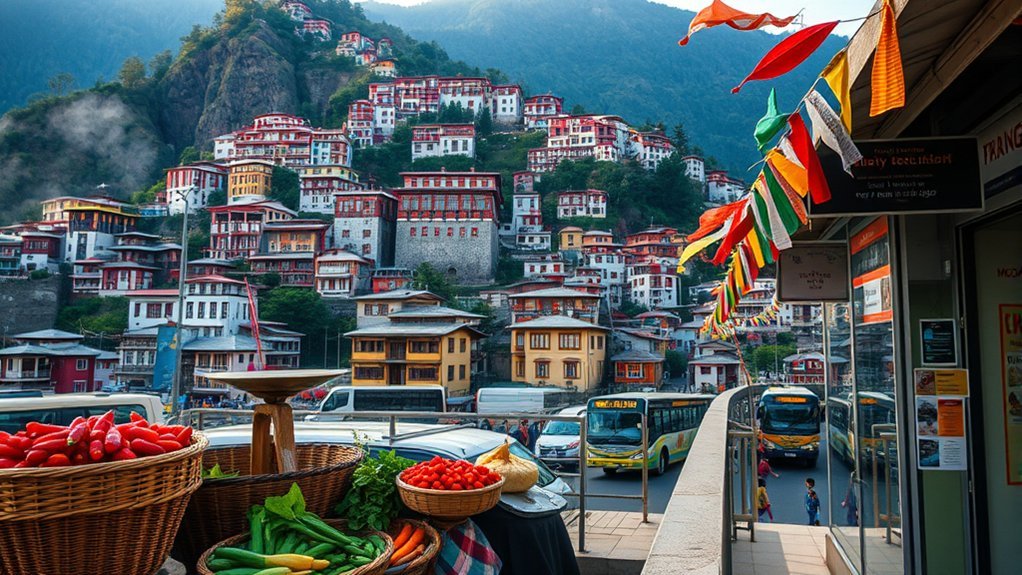
If you want to stretch income in Bhutan, prioritize housing, food, and transit—these categories are dramatically cheaper than in the U.S., so reallocating budget lines yields big gains: you can use targeted savings strategies and budgeting tips to convert lower living costs into faster financial progress.
A one-bedroom in Thimphu averages $122.58 vs much higher U.S. rents; groceries (bread $0.89, eggs $1.96/dozen) and dining out (~$2.82 per meal vs $19.45) free up cash for investment or emergency funds.
- Track fixed costs: allocate rent, utilities, and a $4.01 monthly transit pass first for reliable cashflow.
- Optimize food spend: combine cheap dining out with groceries to reduce per-meal cost.
- Prioritize childcare savings: private preschool ~$235.40 vs $1,387.27 in the U.S.; redirect gap to savings.
- Formalize financial planning: set monthly targets, automate transfers, and measure progress quarterly.
These practical, data-driven steps let you convert Bhutan’s low prices into measurable wealth-building.
Frequently Asked Questions
Is Living in Bhutan Expensive?
No, it isn’t expensive: you’ll find cost factors like cheap housing, meals, groceries and transit lower than in the U.S.; your lifestyle choices and expat experiences still matter, so compare budgets, preferences, and local data carefully.
How to Live in Bhutan as an American?
If you’re serious, investigate whether Bhutan’s strict visa requirements block long stays; then plan cultural adaptation, compare housing options, secure sponsorship or employment, budget using local cost data, and arrange healthcare, permits, and reliable local contacts.
How Much Does a Meal Cost in Bhutan?
You’ll find meal prices in Bhutan very affordable: local cuisine meals average $2.82–$3.38, lunch around $3.24, dinner for two about $17.80, offering budget-friendly dining experiences compared to U.S. costs.
Why Does It Cost $250 a Day to Visit Bhutan?
Curious why it’s $250 a day? You’re paying tourism policies that bundle daily expenses—accommodation, meals, guides, permits—so you get extensive cultural experiences, data-driven preservation, and comparative value versus unmanaged, cheaper but disruptive alternatives.
Conclusion
Concluding costs clearly: compared with the United States, Bhutan’s basic basket is broadly cheaper but benefits, bargains and burdens vary by city. You’ll pay less for local food and transport, more for imported goods, and see sharper rent ranges in Thimphu versus smaller towns. Use salary, savings and spending stats to strategize — seek subsidized services, split shared housing, compare grocery unit prices and cut commuting costs to conserve cash while conserving cultural capital.

